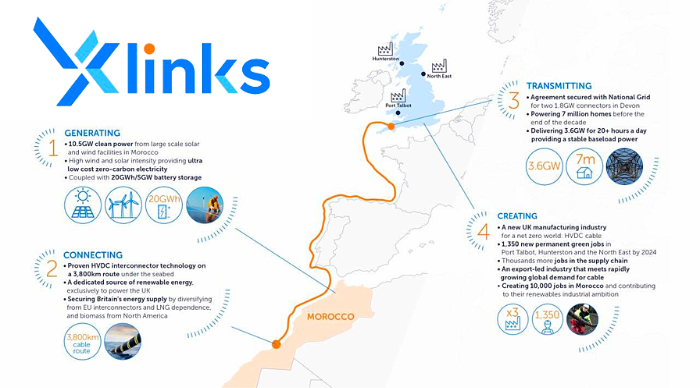Morocco, a trailblazer in renewable energies, is reshaping its energy landscape. With the bold ambition to achieve 52% of its energy capacity from renewable sources by 2030, the North African kingdom positions itself as a leader in green energy. This transition to cleaner and more sustainable energy reflects Morocco’s commitment to innovation and sustainable development. In this dynamic context, the Xlinks Morocco – United Kingdom project emerges not just as an extension of this vision, but as a revolution in international energy interconnection.
This pioneering project aims to establish a 3,800 km link between the Kingdom of Morocco and the United Kingdom, using HVDC technology to transport electricity generated from Morocco’s vast renewable resources. This initiative aligns perfectly with Morocco’s strategy for renewable energy development, offering a unique opportunity to share its abundant energy resources with the world while contributing to the reduction of the global carbon footprint.
Innovation in energy interconnection
- Cable length and complexity: The project plans to lay a 3,800 km submarine cable, a feat in terms of length and technical complexity. This cable will cross various maritime territories and geographical zones, requiring advanced planning and engineering.
- Use of HVDC technology: Employing HVDC technology for such a distance is innovative in itself. This technology allows for more efficient energy transport with fewer losses, crucial for international energy links.
Innovation in renewable energy utilization
- Massive production capacities: The project envisions constructing a 7 GW solar power plant and a 3.5 GW wind farm in Morocco. These facilities would be among the largest in the world, showcasing innovative and large-scale use of renewable energies.
- Energy storage: The innovative aspect is further enhanced by the large-capacity energy storage system (5 GW / 20 GWh), addressing the intermittency of renewable sources.
Economic model and international cooperation
- New energy trade model: The project is based on an innovative economic model where renewable energy is produced in one country and exported to another, creating a new dynamic in international energy trade.
- Transnational cooperation: The project is an example of transnational cooperation in energy, paving the way for future collaborations between countries in exploiting and sharing renewable resources.
Implications for the energy transition
- Carbon footprint reduction: By providing clean and renewable energy on a large scale, the project significantly contributes to reducing the carbon footprint, a crucial aspect of combating climate change.
- Model for other regions: The success of this project could serve as a model for other regions worldwide, encouraging the adoption of interconnected, large-scale renewable energy solutions.
Technical challenges and innovative solutions
- Navigation in shallow waters: Laying cables in shallow waters over such a distance requires innovative technical solutions to ensure the cable’s durability and maintenance.
- Project management and logistics: Managing a project of such magnitude involves innovation in planning, logistics, and international coordination.
In summary, the Xlinks Morocco – UK project stands out for its innovation in energy interconnection, renewable energy utilization, economic model, and international cooperation, contributing to the global energy transition and overcoming complex technical challenges.




